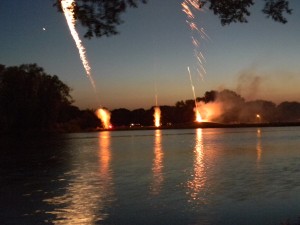Wild Warner has not taken a position on the future of Rhythm and Booms. It has chosen instead to support a study of the wetland before and after the 20th Rhythm and Booms on June 30, 2012.
Jim Carrier, who founded Wild Warner, wrote this personal oped for the Capitol Times, published on August 17, 2011. It is reprinted here as it appeared in the paper:
Four summers ago I walked across the street and watched my first Rhythm & Booms. Sprawled with neighbors on a hill I marveled as a giant red veil of sparks fell slowly to earth over Warner Park, accompanied by “Rhythm of the Rain” from 1,000 radios.
This year, the song’s lyrics reminded me, “what a fool I’d been.”
By dawn’s early light on July 3, hours after 13,000 shells were fired over it, Warner’s 60-acre wetland resembled a war zone. Hundreds of pounds of cardboard canisters, half-burned fuses, rope, wire and charred paper littered the marsh island and floating sedge. Heavy casings resembling turtle shells were half submerged in the lagoon. By day’s end they had disappeared, sunk to the sediment. Somewhere in the goop, too, was residue of chemicals and heavy metals that had turned the sky that cheery red.
After two decades of raining pollution into Warner Park, which drains into Lake Mendota and the Yahara River system, it’s time to consider whether Rhythm & Booms is worth its environmental and financial cost.
On Monday, Aug. 22, Mayor Paul Soglin’s Community Budget Conversation turns to city parks. The meeting is 7-9 p.m. at Orchard Ridge United Church of Christ, 1501 Gilbert Road. “Everything is on the table,” said Soglin assistant Katie Crawley — including whether Madison should repeat Rhythm & Booms for the 20th time.
Alder Satya Rhodes-Conway, whose district encompasses Warner Park, favors a one- or two-year contract, as opposed to five years, “while we have a larger, more public process to discuss how we should celebrate the Fourth as a city, and how Rhythm & Booms fits with our values as a city.”
I’d like a break. I have grown weary of a circus that has become longer, louder, and increasingly jingoistic in an attempt to prop up its unsustainable budget. Bombs bursting in air and the thunder of F16s no longer remind me of America’s founding promise. I think of young people dying in Afghanistan — in U.S. uniforms and wedding gowns — and of critters large and small cowering in a city park.
The nonprofit Rhythm & Booms tells the IRS that “close to 300,000 people … attend … at Warner Park.” That’s 61 percent of Dane County, an absurd claim.
Yet community donations dropped $84,000 between 2005 and 2009, while the city’s subsidy has grown from $50,000 to near $100,000. This year 194 city police worked the event.
In 2009, the last IRS form available, the event spent $145,000 on fireworks and site preparation and $50,000 on insurance. But it donated only $2,080 to children’s charities, one of its two “primary exempt” purposes. This year, after breaking even, nothing will be distributed, according to Madison Fireworks Fund Vice President Debra McCue.
The cost to Warner’s natural world is unmeasured. The fireworks often set fire to nesting areas used by some of its 115 species of birds. Based on how dogs react — neighbors drug their pets or board them out — we can imagine the terror felt by Warner’s fox, deer and mink families. The effect on aquatic life has never been thoroughly tested.
If Madison won’t cancel the fireworks, as Chicago and Salt Lake have, or find a laser alternative, Soglin should reduce the city’s subsidy by $50,000, the amount that the Committee on Environment has asked for a thorough study of how Rhythm & Booms affects Warner’s wetland and its wildlife.
Writer and filmmaker Jim Carrier chairs Wild Warner (www.wildwarner.org), a nonprofit group that is studying the effects of Rhythm & Booms.
You must be logged in to post a comment.